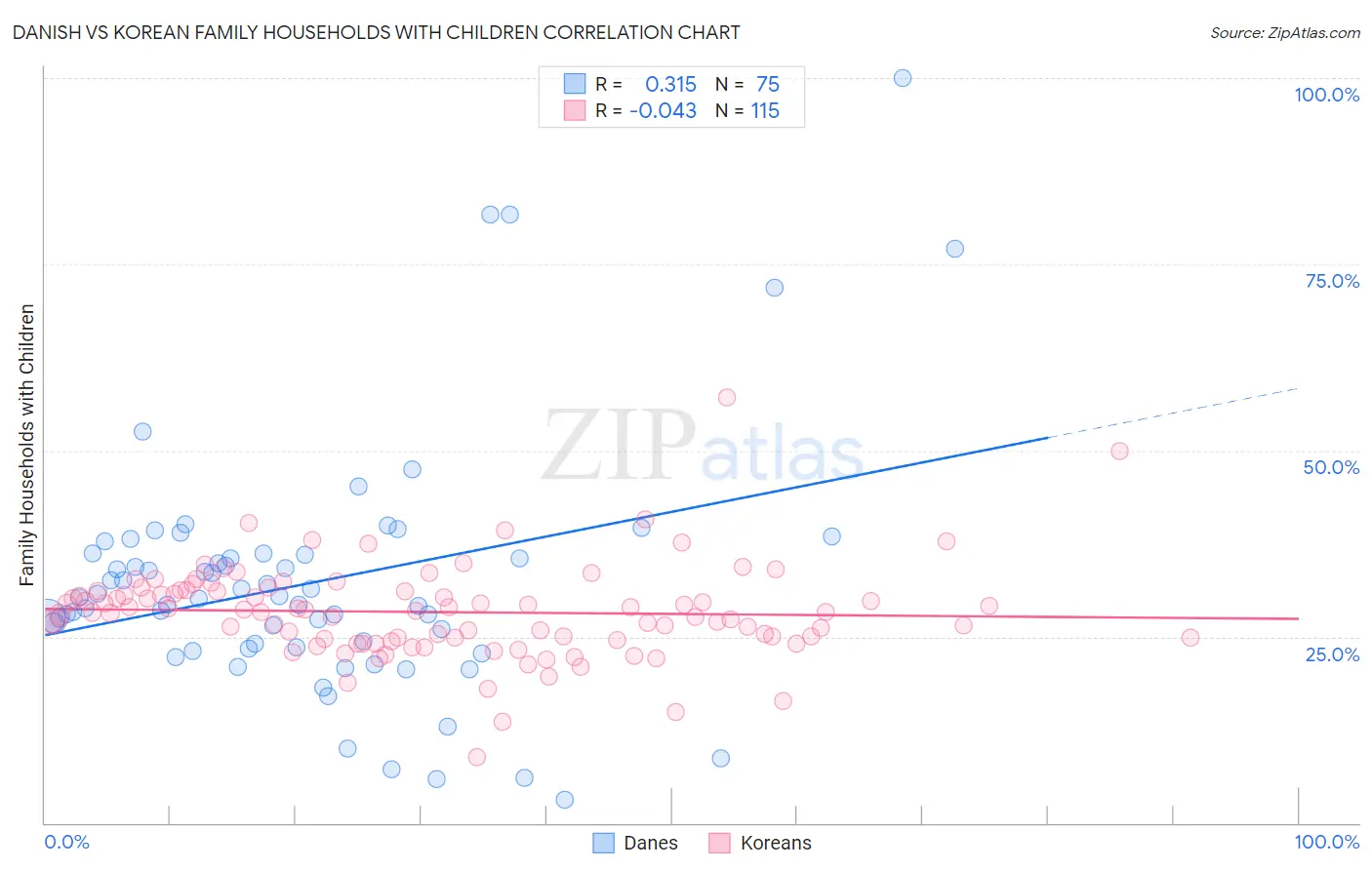Danish vs Korean Family Households with Children
COMPARE
Danish
Korean
Family Households with Children
Family Households with Children Comparison
Danes
Koreans
28.7%
FAMILY HOUSEHOLDS WITH CHILDREN
100.0/ 100
METRIC RATING
57th/ 347
METRIC RANK
29.2%
FAMILY HOUSEHOLDS WITH CHILDREN
100.0/ 100
METRIC RATING
38th/ 347
METRIC RANK
Danish vs Korean Family Households with Children Correlation Chart
The statistical analysis conducted on geographies consisting of 473,642,797 people shows a mild positive correlation between the proportion of Danes and percentage of family households with children in the United States with a correlation coefficient (R) of 0.315 and weighted average of 28.7%. Similarly, the statistical analysis conducted on geographies consisting of 510,137,043 people shows no correlation between the proportion of Koreans and percentage of family households with children in the United States with a correlation coefficient (R) of -0.043 and weighted average of 29.2%, a difference of 1.5%.

Family Households with Children Correlation Summary
| Measurement | Danish | Korean |
| Minimum | 3.0% | 8.8% |
| Maximum | 100.0% | 57.1% |
| Range | 97.0% | 48.3% |
| Mean | 32.3% | 28.3% |
| Median | 30.2% | 28.4% |
| Interquartile 25% (IQ1) | 23.6% | 24.8% |
| Interquartile 75% (IQ3) | 36.1% | 31.1% |
| Interquartile Range (IQR) | 12.5% | 6.3% |
| Standard Deviation (Sample) | 16.7% | 6.3% |
| Standard Deviation (Population) | 16.6% | 6.3% |
Demographics Similar to Danes and Koreans by Family Households with Children
In terms of family households with children, the demographic groups most similar to Danes are Immigrants from Guatemala (28.8%, a difference of 0.24%), Immigrants from Asia (28.8%, a difference of 0.31%), Sierra Leonean (28.9%, a difference of 0.38%), Immigrants from Cambodia (28.9%, a difference of 0.45%), and Guatemalan (28.9%, a difference of 0.52%). Similarly, the demographic groups most similar to Koreans are Immigrants from Cameroon (29.2%, a difference of 0.14%), Yaqui (29.1%, a difference of 0.15%), Central American (29.1%, a difference of 0.16%), Immigrants from South Eastern Asia (29.1%, a difference of 0.25%), and Spanish American Indian (29.1%, a difference of 0.26%).
| Demographics | Rating | Rank | Family Households with Children |
| Immigrants | Cameroon | 100.0 /100 | #37 | Exceptional 29.2% |
| Koreans | 100.0 /100 | #38 | Exceptional 29.2% |
| Yaqui | 100.0 /100 | #39 | Exceptional 29.1% |
| Central Americans | 100.0 /100 | #40 | Exceptional 29.1% |
| Immigrants | South Eastern Asia | 100.0 /100 | #41 | Exceptional 29.1% |
| Spanish American Indians | 100.0 /100 | #42 | Exceptional 29.1% |
| Asians | 100.0 /100 | #43 | Exceptional 29.1% |
| Immigrants | Taiwan | 100.0 /100 | #44 | Exceptional 29.0% |
| Fijians | 100.0 /100 | #45 | Exceptional 29.0% |
| Immigrants | Philippines | 100.0 /100 | #46 | Exceptional 29.0% |
| Peruvians | 100.0 /100 | #47 | Exceptional 29.0% |
| Apache | 100.0 /100 | #48 | Exceptional 29.0% |
| Jordanians | 100.0 /100 | #49 | Exceptional 29.0% |
| Immigrants | Immigrants | 100.0 /100 | #50 | Exceptional 28.9% |
| Immigrants | Peru | 100.0 /100 | #51 | Exceptional 28.9% |
| Guatemalans | 100.0 /100 | #52 | Exceptional 28.9% |
| Immigrants | Cambodia | 100.0 /100 | #53 | Exceptional 28.9% |
| Sierra Leoneans | 100.0 /100 | #54 | Exceptional 28.9% |
| Immigrants | Asia | 100.0 /100 | #55 | Exceptional 28.8% |
| Immigrants | Guatemala | 100.0 /100 | #56 | Exceptional 28.8% |
| Danes | 100.0 /100 | #57 | Exceptional 28.7% |